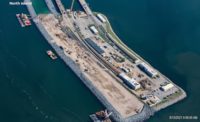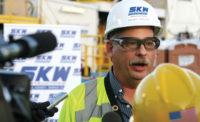Originally scheduled for completion late this year, the new 4,300-ft-long Midtown Tunnel between Norfolk and Portsmouth, Va., is now on track for completion by the end of the summer. The Elizabeth River Crossings (ERC) project team opened one of the two lanes to traffic last month, marking a milestone in one of the nation’s largest public-private-partnership infrastructure projects.
ERC—a concessionaire that includes Australia’s Macquarie Group and a design-build joint venture of Skanska USA, Kiewit Construction and Weeks Marine Inc. (SKW)—began the $2.1- billion project in 2012. The team assumed operation of the 53-year-old state-owned Midtown Tunnel and the nearby twin-tube Downtown Tunnel, which also needed upgrades. Handling 37,000 vehicles daily, the original Midtown Tunnel was the most burdened two-lane road east of the Mississippi River, according to ERC.
The 58-year design-build-finance-operate-maintain concession called for tolls on once-free tunnels, sparking a lawsuit that challenged the constitutionality of transferring infrastructure from the Virginia Dept. of Transportation into private hands. The state Supreme Court ruled in favor of ERC, allowing tolling to begin in February 2014.
Since then, construction has proceeded relatively quietly. But a number of technical feats and innovations were necessary to complete what ERC says is the first all-concrete highway tunnel in the U.S. designed for deepwater immersion.
“This was the most cost-effective solution, as long as certain factors were in place,” says Wade Watson, Skanska vice president and project director. “And, fortunately, we had them.”
Topping the list, Watson says, was the availability of a deepwater facility suitable for fabricating the new tunnel’s eleven 16,000-ton reinforced-concrete segments, each 53 ft, 11 in., wide, 28.5 ft high and 330 ft to 356 ft long.
The answer was found 220 nautical miles up the Chesapeake Bay, at the former Sparrows Point industrial site in Baltimore. While fitting out a leased drydock with two batch plants and other facilities to support massive pours, SKW tested dozens of concrete mixes before finding a recipe that satisfied the durability requirements of a 120-year design life.
Watson notes that while the design called for compressive strengths of 6,000 psi, “typically, our concrete reaches strengths in the 9,000- to 10,000-psi range.” Approximately 75,000 cu yd of that high-strength concrete and 16 tons of steel rebar were blended to create the tunnel elements’ 3- to 3.5-ft-thick exterior walls. Each element was fitted with temporary bulkheads and the two-gasket Trelleborg sealing system to facilitate underwater assembly, as well as remote-controlled ballast tanks that would also help to maintain the 3 ft of freeboard buoyancy necessary to safely tow the segments to Portsmouth.
“We came within one inch of the predicted value on each segment when it was launched,” Watson says.
Pulling It Together
Underwater excavation equipment controlled from a customized barge excavated 1.2 million cu yd of material from the Elizabeth River’s bed and graded 40,000 tons of sand and aggregate for the tunnel’s 2-ft-thick foundation.
SKW initially designed the new tube to run parallel to the original tunnel, but it incorporated a design change: a lateral curve that provided an extra safeguard against the risk of structural damage during dredging and construction. Separated from the old tunnel by 75 ft at the portals, the new tube arcs, at its greatest length, to a distance of 250 ft; at that point, the tunnel also reaches its deepest point, 95 ft below the surface. Bradley Weidenhammer, VDOT district megaprojects engineer, says the change required approval of the modified environmental documents but caused no delays.
From another specially equipped barge, SKW used a combination of concrete weights and a 12-cell ballast system to submerge and guide each element to within 3 ft of the previously installed unit, a process that took about 12 hours. Hydraulic jacks pulled the elements together, with the Trelleborg gaskets compressing water from between the temporary bulkheads to create a watertight seal. Crews staged some 675,000 tons of backfill and placed 68,000 tons of riprap on the top to provide protection from anchors.
As construction progressed into the busy channel, part of the Intercoastal Waterway, SKW coordinated with commercial carriers, the Coast Guard and the U.S. Navy to schedule partial and full 48-hour closures. Watson adds, “We were always ready to move quickly out of the way if the military needed to get through.”
With all the elements in place and the temporary bulkheads removed, SKW transformed the interior of the heavy concrete rectangles into a modern two-lane underwater throughway, complete with a wall-separated emergency egress corridor, LED lighting, a high-capacity sprinkler system, interior air sensors and a high-efficiency longitudinal ventilation system.
The Norfolk portal sports a 40,000-lb, 20-in.-thick movable steel floodgate system to protect against a 500-year flood event and a 2-ft rise in sea level.
In June, VDOT certified the structure’s readiness using the Federal Highway Administration’s 2015 National Tunnel Inspection Standard, an industry first. SKW expects to complete mechanical and electrical system overhaul of the original tunnel by fall 2017.
A companion project, a one-mile extension of the Martin Luther King Expressway with a new interchange at Interstate 264, is scheduled to be ready by the end of this year. “Our thinking now is that the entire project will be done 10 months early,” Watson says, an accomplishment he credits to the collaborative dynamics fostered by the P3 and design-build processes that cut the schedule of a 10-year project by more than half.








Post a comment to this article
Report Abusive Comment